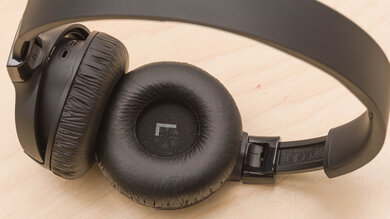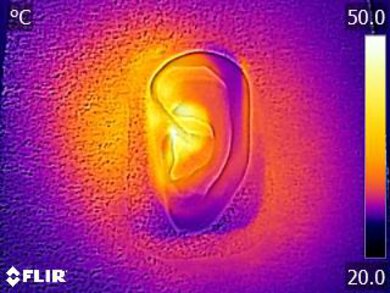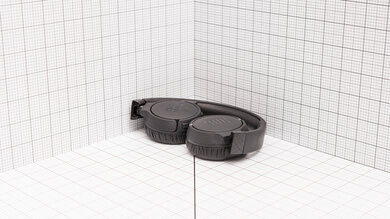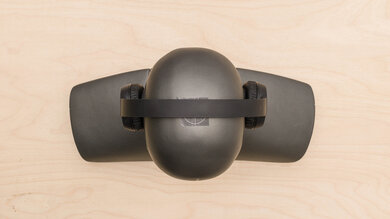The JBL Tune 660NC Wireless are on-ear Bluetooth headphones. They have an active noise cancelling (ANC) feature to help block out ambient sound and support multi-device pairing, so you can stay connected with two devices simultaneously. You can also use them wired with the included audio cable. However, they don't have a companion app and lack sound customization features.
Our Verdict
The JB Tune 660NC are good for neutral sound. They deliver sound consistently and have a slightly v-shaped sound profile, adding a bit of extra rumble, punch, and brightness. Sibilant sounds like cymbals are slightly piercing and harsh, though. Their soundstage doesn't seem very open or spacious, which is typical for closed-back headphones. Unfortunately, they also lack any sound customization features.
- Convenient onboard controls.
- Good frequency response consistency.
- No sound customization features.
The JBL Tune 660NC are fair for commuting and traveling. They have an ANC feature, but it does a poor job of isolating you from noise, especially bass-range sounds like rumbling bus and plane engines. Their roughly 42-hour battery life will be long enough for long trips, though, and they have easy-to-use controls. Unfortunately, they don't have the most comfortable fit and don't come with a carrying case or pouch.
- Very good battery performance.
- Convenient onboard controls.
- Disappointing ANC performance.
- No carrying case or pouch included.
The JBL Tune 660NC are okay for sports and fitness. Like a lot of on-ear headphones, they aren't very portable. They also do a poor job of staying in place when you move around, so they aren't very well-suited for more intense workouts. On the plus side, they won't make your ears feel too hot and have easy-to-use controls on one ear cup, so you can adjust your music's volume or skip a song without taking out your phone.
- Convenient onboard controls.
- Good breathability.
- Mediocre build quality.
- No IP rating for water resistance.
The JBL Tune 660NC are alright for office use. Their ANC feature does a sub-par job of blocking background noise, and they aren't the most comfortable. However, they have a long continuous battery life of roughly 42 hours and don't leak very much audio, so you can listen to your music at fairly high volumes without bothering people nearby. You can pair them with multiple devices simultaneously, so you can easily switch between listening to audio on your phone and computer.
- Support multi-device pairing.
- Don't leak too much sound.
- Disappointing ANC performance.
- May not be comfortable for long sessions.
The JBL Tune 660NC are Bluetooth headphones you can't use wirelessly with PlayStation or Xbox consoles. They're compatible with Bluetooth-enabled PCs, but their latency is likely too high to be suitable for wireless gaming.
The JBL Tune 660 are decent for wired gaming. You can plug them into a PlayStation or Xbox controller with the included 1/8" TRS cable to receive audio, but you can't use the integrated microphone. Their sound profile helps emphasize sound effects in action-packed games, but unfortunately, they aren't very comfortable, so they may not be ideal for long gaming sessions.
- 1/8" TRS cable included.
- May not be comfortable for long sessions.
The JBL Tune 660NC are alright for making phone calls. The integrated mic makes your voice sound thin, but it's still clear and easy to understand. They support multi-device pairing and have easy-to-use buttons on one earcup that allow you to answer, end, and decline calls without pulling out your phone. Unfortunately, the ANC system doesn't block out very much ambient sound, and the mic struggles to separate your voice from background noise, so these headphones aren't ideal for taking calls in a loud environment like a subway station.
- Convenient onboard controls.
- Decent mic recording quality.
- Disappointing ANC performance.
- Mic has mediocre noise handling.
Changelog
- Updated May 24, 2024: We've added a comparison between these headphones and the JBL Live 670NC Wireless in Noise Isolation - Full Range.
- Updated Aug 11, 2023: Made minor edits to the text to bring it up to date.
- Updated Aug 08, 2023: We've retested their imaging performance because of an error that resulted in '0' frequency mismatch between drivers. The score of that test has changed. This resulted in slight changes to the sound profile and the scores of the rest of the sound-related tests.
- Updated Nov 01, 2021: Converted to Test Bench 1.5.
Check Price
Differences Between Sizes And Variants
The JBL Tune 660NC Wireless headphones come in a few different colors: 'Black,' 'White', 'Blue', and 'Pink'. We tested the 'Black' variant but expect our results to be valid for the others too. You can see the label for the unit we tested here.
If you come across another variant or your headphones are different, please let us know in the forums so we can update our review.
Popular Headphones Comparisons
The JBL Tune 660NC are Bluetooth on-ear headphones similar to the JBL Tune 510BT Wireless headphones but with an added ANC feature. Unfortunately, it does a sub-par job of isolating you from noise compared with other ANC on-ear headphones, like the Beats Solo Pro Wireless and the JBL Live 460NC Wireless.
If you're looking for other options, check out our lists of the best on-ear headphones, the best noise cancelling headphones, and the best wireless Bluetooth headphones.
The JBL Live 460NC Wireless are slightly better on-ear headphones than the JBL Tune 660NC Wireless. The Live 460NC are more comfortable and feel better-built. They have a better performing active noise cancelling (ANC) feature and are compatible with the JBL Headphones app, which allows you to adjust their sound profile using their parametric EQ and presets. However, the Tune 660NC have longer continuous battery life.
The JBL Tune 660NC Wireless and Sony WH-CH520 Wireless are on-ear Bluetooth headphones. Of the two, only the JBL have active noise cancelling (ANC), which isn't impressive, but it reduces ambient chatter and traffic noise more effectively than the Sony. They also fold down smaller with more comprehensive controls. Their sound is much more bass-heavy without an app to adjust the EQ. The battery life of the Sony headphones lasts longer. Their sound profile is more balanced with an app for EQ and virtual surround sound. Unfortunately, their passive-only noise isolation only suppresses high-pitched sounds like shrill brakes. However, their headband is better padded and more comfortable to wear.
The JBL Tune 660NC Wireless are better than the JBL Tune 510BT for most purposes. They have longer continuous battery life and leak less audio. They also have an ANC feature that blocks out much more ambient noise than the 510BT can passively, but their noise isolation performance is sub-par overall. On the other hand, the 510BT deliver sound more consistently.
The JBL Tune 660NC Wireless and the JBL Live 670NC are both on-ear headphones, though the Tune have a retail price that's a little over half that of the Live. Despite their lower price tag, the Tune are superior in a surprising number of aspects: they have a more balanced sound profile with a prominent bass that's not as bloated and overwhelming as the Live's. They also have a better mic recording quality and better mic noise handling. That said, the Live have a slightly better performing ANC system and a much longer continuous battery life at 88 hours. They're also better-built and more comfortable to wear across extended listening sessions.
Test Results

These are on-ear headphones with a simple, quite nondescript appearance. They have a narrow plastic headband and the manufacturer's logo stamped onto each small round ear cup. They're available in a few different colors, including 'Black', the variant we tested, and 'Blue', 'White', or 'Pink'.
They're fairly comfortable. They're light and don't put too much pressure on your head. The ear cups' hinges also have a good range of motion. Unfortunately, the headband only has a small amount of padding in the middle, which may make them a little less comfortable if you wear them for long periods.
They have good controls. The buttons are all found on the right ear cup and are easy to distinguish from each other. The buttons are clicky, and you hear audio cues when you reach maximum or minimum volume and when you pair the headphones with a device via Bluetooth.
'+' and '-' buttons:
- Single press: Raise or lower the volume.
- Press and hold: Skip the track forward or backward.
Center button:
- Single press: Play/pause audio or answer/end a call.
- Press and hold: Decline a call.
- Double tap: Activate voice assistant.
ANC button:
- Single press: Turn ANC on/off. When in a call, mutes or unmutes the mic.
They're reasonably portable. The ear cups swivel to lay flat, making the headphones more compact and easier to store or fit into a bag. However, they don't come with a carrying case or pouch to protect them when you're on the go.
They have an unremarkable build quality. They're made of cheap-feeling plastic, and the faux leather padding on the headband isn't very comfortable. While the ear cups have a good range of motion, the headphones' yokes and hinges don't feel particularly solid. They aren't rated for dust or water resistance, but that's the norm for on-ear headphones.
They aren't very stable. Like the JBL Tune 510BT Wireless, they aren't intended for workouts and are likely to fall off your head, even during moderate exercise like a jog in the park.
JBL Tune 660NC have a slightly V-shaped sound profile. It lends mixes some extra rumble and punch. Voices and instruments sound clear and accurate but are slightly veiled by an underemphasis in the low-treble. Sibilants are also bright and somewhat piercing. Unfortunately, they don't have an EQ or presets to help customize their sound profile.
They have good frequency response consistency. Their bass delivery is fairly consistent, but you may experience a drop in bass if you wear glasses or have thick hair. There's also some inconsistency in the mid and treble ranges depending on the headphones' fit and positioning, so you may need to take the time to adjust them each time you wear them to get a consistent sound.
The JBL Tune 660NC have very good bass accuracy. The low and mid-bass ranges are overemphasized, which adds thump, rumble, and punch to your music. There's also a bit of extra high-bass, which adds warmth and a bit of boominess.
They have fantastic mid accuracy. The range is even and well-balanced, so vocals and lead instruments sound clear, present, and accurate.
The JBL Tune 660NC have okay treble accuracy. There's some underemphasis in the low treble, so voices in songs like the chorus of Homemade Dynamite by Lorde sound veiled instead of clear. The peak in the mid-treble adds brightness but also makes sibilants like cymbals or S and T sounds seem harsh and piercing.
They have an okay peaks and dips performance. There are peaks and dips across the range, indicating that the headphones struggle somewhat to control their sound profile. A shallow dip in the mid to high-bass adds body and boom, while a dip across the low-treble slightly veils instruments and lead vocals. There's also a dip in the mid-treble followed by a bigger peak in the same range, making sibilants like S and T sounds seem alternately piercing and dull.
They have excellent imaging performance. JBL headphones tend to have well-matched drivers, which results in good imaging and indicates the brand's quality control and ergonomics. Our unit's weighted group delay is almost entirely below the audibility threshold, except for a very small bump in the bass range which loosens their bass ever so slightly. However, it's not very noticeable overall. Also, the L/R drivers of our unit are well-matched in terms of amplitude, frequency, and phase response, so objects like voices and footsteps are accurately placed within the stereo image. However, imaging varies from unit to unit.
The JBL Tune 660NC have a poor passive soundstage. While you'll perceive sound as coming from speakers placed in the room around you rather than from inside your head, the soundstage doesn't seem very natural or wide. It's also not very open or spacious, which is typical of closed-back headphones.
The JBL Tune 660NC have a good weighted harmonic distortion performance. At moderate volumes, there's some distortion in the mid-treble range. A narrow peak also affects a small range of low-bass frequencies in the right driver. However, it's hard for most people to hear with real-life content, and otherwise, all frequencies fall within good limits, resulting in clean and pure audio reproduction.
These are the settings used to test the JBL Tune 660NC Wireless. Our results are only valid when you use the headphones in this configuration.
The JBL Tune 660NC have sub-par noise isolation. They have an ANC system that doesn't isolate you well from bass-range sounds like rumbling bus or plane engines. It does an okay job of blocking out higher-pitched noises, like a background conversation or humming A/C unit, but it's still not quite on par with other JBL on-ears like the JBL Live 670NC Wireless.
The JBL Tune 660NC Wireless have a good leakage performance. They leak less audio than the JBL Tune 510BT Wireless, and you can listen to music at high volumes in a moderately quiet environment, like an office, without much risk of bothering people around you.
The integrated mic has a decent performance. Recorded speech sounds thin but fairly clear and easy to understand.
The integrated mic has a mediocre noise handling performance. In moderately noisy places like an office, background noise is still audible and distracting during calls. It can be difficult to understand or even hear you if you're on the phone somewhere loud, like a subway station.
The JBL Tune 660NC's battery performance is very good. With their ANC on, they last for about 42 hours of continuous use, which is close to the advertised 44-hour battery life with ANC on. The manufacturer also advertises that they last for 55 hours with the ANC off, and they have a five-minute quick-charge feature for two hours of playback. Unfortunately, they don't have any power-saving features like an auto-off timer or standby mode. If you run out of battery life, you can use the headphones passively with the included audio cable. Also, battery performance can vary with real-life use.
They have great Bluetooth connectivity. You can pair them with up to two devices simultaneously, allowing you to switch from listening to music on your phone to watching a movie on your computer without re-pairing the headphones. An incoming call always takes priority, no matter what device's audio you're listening to, though. Unfortunately, their latency on PCs and iOS and Android devices is somewhat high, so you're likely to notice some audio lag if you're gaming or watching videos. That said, some apps and devices seem to compensate for latency.
You can use these headphones wired with their included 1/8" TRS to TRRS cable. However, you can only receive audio using this cable as the TRS connector can't simultaneously transmit stereo audio or mic audio. They also come with a USB-C to USB-A cable to charge the headphones.
These on-ears support a wireless connection with PCs via Bluetooth but have high latency when used that way. They can also receive audio via analog connection, eliminating latency, but you can't use the mic.
The JBL Tune 660NC can only connect with PlayStation consoles with the included 1/8" TRS cable. You can hear audio but not use the mic.
The JBL Tune 660NC are compatible with Xbox and Xbox Series X if you plug their 1/8" TRS cable into a controller. However, you can only receive audio.














